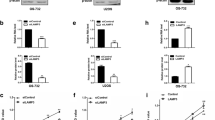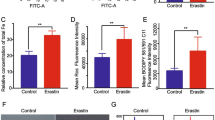Abstract
Protein tyrosine phosphatase receptor type C (PTPRC) is reported to function as an oncogenic role in various cancer. However, the studies on the roles of PTPRC in osteosarcoma (OS) are limited. This study aimed to explore the potentials of PTPRC in OS. mRNA levels were detected by reverse transcription-quantitative polymerase chain reaction (RT-qPCR). Protein expression was detected by western blot. Lysosome biogenesis was determined using immunofluorescence. The binding sites of transcription factor EB (TFEB) on the promoter of ferritin heavy chain 1 (FTH1) were predicted by the online dataset JASPAR and confirmed by luciferase and chromatin immunoprecipitation (ChIP) assays. Cell death was determined using propidium iodide (PI) and TdT-mediated dUTP nick-end labeling (TUNEL) staining. The results showed that PTPRC was significantly overexpressed in OS tissues and cells. PTPRC knockdown promoted the phosphorylation and nuclear translocation of TFEB. Moreover, PTPRC knockdown markedly promoted lysosome biogenesis and the accumulation of ferrous ion (Fe2+), whereas decreased the release of glutathione (GSH). Besides, PTPRC knockdown significantly promoted autophagy and downregulated mRNA expression of FTH1 and ferritin light chain (FTL). Additionally, TFEB transcriptionally inactivated FTH1. PTPRC knockdown significantly promoted the ferroptosis of OS cells, which was markedly alleviated by TFEB shRNA. Taken together, PTPRC knockdown-mediated TFEB phosphorylation and translocation dramatically promoted lysosome biogenesis, ferritinophagy, as well as the ferroptosis of OS cells via regulating FTH1/FTL signaling. Therefore, PTPRC/TFEB/FTH1 signaling may be a potential target for OS.






Similar content being viewed by others
Data Availability
The datasets used and analyzed during the current study are available from the corresponding author on reasonable request.
References
Huang, X., et al. (2022). Engineered exosome as targeted lncRNA MEG3 delivery vehicles for osteosarcoma therapy. Journal of Controlled Release : Official Journal of the Controlled Release Society, 343, 107–117.
Ritter, J., & Bielack, S. S. (2010). Osteosarcoma. Annals of Oncology, 21(Suppl 7), vii320–vii325.
Lilienthal, I., & Herold, N. (2020). Targeting Molecular Mechanisms Underlying Treatment Efficacy and Resistance in Osteosarcoma: A review of current and future strategies. International Journal of Molecular Sciences, 21, 18.
Meltzer, P. S., & Helman, L. J. (2021). New Horizons in the treatment of Osteosarcoma. New England Journal of Medicine, 385(22), 2066–2076.
Chi, X., et al. (2021). Genomic analysis revealed Mutational Traits Associated with Clinical Outcomes in Osteosarcoma. Cancer Manag Res, 13, 5101–5111.
Jiang, X., et al. (2021). Ferroptosis: Mechanisms, biology and role in disease. Nature Reviews Molecular Cell Biology, 22(4), 266–282.
Tang, D., et al. (2021). Ferroptosis: Molecular mechanisms and health implications. Cell Research, 31(2), 107–125.
Xue, X. (2022). Tumour cells are sensitised to ferroptosis via RB1CC1-mediated transcriptional reprogramming. Clin Transl Med 12 (2), e747.
Long, F. (2023). CircZBTB46 protects Acute myeloid leukemia cells from ferroptotic cell death by upregulating SCD. Cancers (Basel) 15 (2).
Ren, T., et al. (2022). Zoledronic acid induces ferroptosis by reducing ubiquinone and promoting HMOX1 expression in osteosarcoma cells. Frontiers in Pharmacology, 13, 1071946.
Muhoberac, B. B., & Vidal, R. (2019). Iron, Ferritin, Hereditary Ferritinopathy, and Neurodegeneration. Front Neurosci, 13, 1195.
Liu, J., et al. (2022). The NSUN5-FTH1/FTL pathway mediates ferroptosis in bone marrow-derived mesenchymal stem cells. Cell Death Discov, 8(1), 99.
Zhang, G., et al. (2023). 1–2 T static magnetic field combined with ferumoxytol prevent unloading-induced bone loss by regulating iron metabolism in osteoclastogenesis. J Orthop Translat, 38, 126–140.
Al Barashdi, M. A., et al. (2021). Protein tyrosine phosphatase receptor type C (PTPRC or CD45). Journal of Clinical Pathology, 74(9), 548–552.
Park, S. Y., et al. (2021). Aberrant activation of the CD45-Wnt signaling axis promotes stemness and therapy resistance in colorectal cancer cells. Theranostics, 11(18), 8755–8770.
Mao, F. Y., et al. (2018). CD45(+)CD33(low)CD11b(dim) myeloid-derived suppressor cells suppress CD8(+) T cell activity via the IL-6/IL-8-arginase I axis in human gastric cancer. Cell Death and Disease, 9(7), 763.
Ko, Y., et al. (2021). Development of a Bioluminescent Human Osteosarcoma Model in Humanized NSG mice: A pilot study. In Vivo, 35(4), 2151–2157.
Yang, H. L., et al. (2022). A defective lysophosphatidic acid-autophagy axis increases miscarriage risk by restricting decidual macrophage residence. Autophagy, 18(10), 2459–2480.
Sha, Y., et al. (2017). STUB1 regulates TFEB-induced autophagy-lysosome pathway. Embo Journal, 36(17), 2544–2552.
Martina, J. A., & Puertollano, R. (2018). Protein phosphatase 2A stimulates activation of TFEB and TFE3 transcription factors in response to oxidative stress. Journal of Biological Chemistry, 293(32), 12525–12534.
Rochette, L. (2022). Lipid peroxidation and Iron metabolism: Two Corner Stones in the Homeostasis Control of Ferroptosis. International Journal of Molecular Sciences 24 (1).
Latunde-Dada, G. O. (2017). Ferroptosis: Role of lipid peroxidation, iron and ferritinophagy. Biochimica Et Biophysica Acta - General Subjects, 1861(8), 1893–1900.
Jiang, T. Y., et al. (2023). PTEN Deficiency facilitates Exosome Secretion and Metastasis in Cholangiocarcinoma by Impairing TFEB-mediated Lysosome Biogenesis. Gastroenterology, 164(3), 424–438.
Toyoshima, K., et al. (2015). Analysis of circulating tumor cells derived from advanced gastric cancer. International Journal of Cancer, 137(4), 991–998.
Guo, G. (2022). PTPRC Overexpression Predicts Poor Prognosis and Correlates with Immune Cell Infiltration in Pediatric Acute Myeloid Leukemia. Clin Lab 68 (7).
Perron, M., & Saragovi, H. U. (2018). Inhibition of CD45 phosphatase activity induces cell cycle arrest and apoptosis of CD45(+) lymphoid tumors Ex vivo and in vivo. Molecular Pharmacology, 93(6), 575–580.
Li, J., et al. (2017). Membrane-proximal Epitope facilitates efficient T cell synapse formation by Anti-FcRH5/CD3 and is a requirement for Myeloma Cell Killing. Cancer Cell, 31(3), 383–395.
Li, M., et al. (2021). ISL1 promoted tumorigenesis and EMT via Aurora kinase A-induced activation of PI3K/AKT signaling pathway in neuroblastoma. Cell Death and Disease, 12(6), 620.
Li, Y., et al. (2023). Correlation analysis of lipid metabolism genes with the immune microenvironment in gastric cancer and the construction of a novel gene signature. Clinical and Translational Oncology, 25(5), 1315–1331.
Xia, H., et al. (2020). Autophagic adaptation to oxidative stress alters peritoneal residential macrophage survival and ovarian cancer metastasis. JCI Insight, 5, 18.
Lei, G., et al. (2022). Targeting ferroptosis as a vulnerability in cancer. Nature Reviews Cancer, 22(7), 381–396.
Fang, L., et al. (2017). Transcriptional factor EB regulates macrophage polarization in the tumor microenvironment. Oncoimmunology, 6(5), e1312042.
Liu, X., et al. (2021). Tubeimoside-1 induces TFEB-dependent lysosomal degradation of PD-L1 and promotes antitumor immunity by targeting mTOR. Acta Pharm Sin B, 11(10), 3134–3149.
Zhu, X., et al. (2021). TFEB promotes prostate Cancer Progression via regulating ABCA2-Dependent lysosomal Biogenesis. Frontiers in Oncology, 11, 632524.
Ravichandran, M., et al. (2022). Coordinated transcriptional and Catabolic Programs Support Iron-Dependent adaptation to RAS-MAPK pathway inhibition in pancreatic Cancer. Cancer Discovery, 12(9), 2198–2219.
Zhang, H. T., et al. (2021). TRIM21-regulated annexin A2 plasma membrane trafficking facilitates osteosarcoma cell differentiation through the TFEB-mediated autophagy. Cell Death and Disease, 12(1), 21.
Wang, Y. (2018). Iron Metabolism in Cancer. International Journal of Molecular Sciences 20 (1).
Yambire, K. F. (2019). Impaired lysosomal acidification triggers iron deficiency and inflammation in vivo. Elife 8.
Zhu, X., et al. (2020). Ribosome recycling by ABCE1 links lysosomal function and Iron homeostasis to 3’ UTR-Directed Regulation and nonsense-mediated decay. Cell Rep, 32(2), 107895.
Wang, S., et al. (2022). 12 T high static magnetic field suppresses osteosarcoma cells proliferation by regulating intracellular ROS and iron status. Experimental Cell Research, 417(2), 113223.
Liu, Z., et al. (2023). Myeloid FTH1 Deficiency protects mice from colitis and colitis-associated Colorectal Cancer via reducing DMT1-Imported Iron and STAT3 activation. Inflammatory Bowel Diseases, 29(8), 1285–1296.
Chan, J. J., et al. (2018). A FTH1 gene:Pseudogene:microRNA network regulates tumorigenesis in prostate cancer. Nucleic Acids Research, 46(4), 1998–2011.
Chen, G. Q., et al. (2020). Artemisinin compounds sensitize cancer cells to ferroptosis by regulating iron homeostasis. Cell Death and Differentiation, 27(1), 242–254.
Author information
Authors and Affiliations
Contributions
Conceptualization: Yan Shao; Methodology: Xiao Zuo; Formal analysis and investigation: Yan Shao, Xiao Zuo; Writing - original draft preparation: Yan Shao, Xiao Zuo; Writing - review and editing: Yan Shao, Xiao Zuo; Resources: Yan Shao; Supervision: Xiao Zuo. Both the authors read and approved the final manuscript.
Corresponding author
Ethics declarations
Conflict of Interest
None.
Additional information
Publisher’s Note
Springer Nature remains neutral with regard to jurisdictional claims in published maps and institutional affiliations.
Yan Shao and Xiao Zuo contributed equally to this study.
Rights and permissions
Springer Nature or its licensor (e.g. a society or other partner) holds exclusive rights to this article under a publishing agreement with the author(s) or other rightsholder(s); author self-archiving of the accepted manuscript version of this article is solely governed by the terms of such publishing agreement and applicable law.
About this article
Cite this article
Shao, Y., Zuo, X. PTPRC Inhibits Ferroptosis of Osteosarcoma Cells via Blocking TFEB/FTH1 Signaling. Mol Biotechnol (2023). https://doi.org/10.1007/s12033-023-00914-9
Received:
Accepted:
Published:
DOI: https://doi.org/10.1007/s12033-023-00914-9




